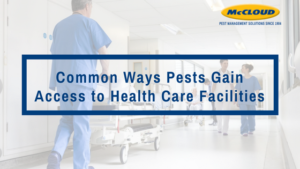Common Ways Pests Gain Access to Your Health Care Facility
By: Patricia Hottel, Technical Director, McCloud Services
Pests can run, crawl, fly and hitch-hike their way into your facility. Some paths are obvious like a door which is left open or poorly sealed, and some not so obvious. Here is a list of the ways pests can enter your facility and the methods for prevention.
 |
Employees
Several urban pests are excellent at hitch-hiking. These include the German cockroach and the common bed bug. We routinely find that when these pests inhabit workplaces, they arrive on the belongings of employees. Having a separate area for employees to store their belongings, including lunches and coats, is critical. Monitoring these areas for pest activity is also important with regularly scheduled employee locker clean-outs as part of the monitoring and inspection process. Facilities should have a policy in place to deal with employees who have been found |
to be the sources of pests such as bed bugs. These policies should be established prior to the first incident since it may require the involvement of multiple departments including human resources.
Patients and Visitors
Unfortunately, pests can be brought into a facility on a patient or individuals visiting a patient. Sometimes the introduction is due to patient health care needs as in the case of ectoparasites like body or head lice. Health care facilities should have a program in place to prepare for these introductions. Staff education is a critical component of the plan. Bed bugs are a relatively new problem for health care facilities and can be brought in on the personal belongings of patients. Although most hospitals are relatively hostile environments for bed bugs to thrive in, they can be more successful in establishing infestations in long term resident care facilities.
Incoming Shipments
Just like pests can hitch-hike on employees, pests can hitch-hike on food and other materials coming to the building. A good inspection of incoming goods is required to make sure that hitch-hikers are excluded. Once the product has been accepted into the site, it can be difficult to establish responsibility for the pest infestation. Pests that may come in on incoming shipments include: rodents, cockroaches and stored product pests. Even small flies can be brought into the site on items like fresh fruits and vegetables.
Floor Drains
Our sewer system can provide an ideal harborage for pests like small flies, cockroaches and rats which then travel into our facilities. Drains which are seldom used for water management can be particularly problematic. Maintaining drains through cleaning and proper grating is essential in helping keep pests from migrating into structures through sewer highways. If a drain is not needed for waste water management, consider capping it. If it is needed and is supporting pest entry, consider using special caps or screened “socks” which will allow liquids to flow down the drain but help keep pests out. Some of these exclusionary devices are designed for insects only and not rodents. Liquid Breaker Green Drain is an example of a one-way valve insert for insect exclusion.
Improperly Functioning Automatic Doors
Automatic doors are often used in health care facilities to allow easy access for patients, especially those who are wheelchair bound. However, doors which are not regularly checked for proper operation may stay open longer than necessary or may stick open. Doors should be inspected for proper operation and timing. This includes inner vestibule and outer vestibule doors. They are all part of the pest defense. Doors which have defective timing or stick open, can permit pest entry.
About the Author
Patricia Hottel is technical director at McCloud Services and has over 35 years of pest management industry experience. Hottel is a board certified entomologist and a member of the National Pest Management Association’s Commercial and Fumigation Committees. She is also a former member of the board of directors of the National Pest Management Association (NPMA) and the Illinois Pest Control Association (IPCA). She has served on the board of directors for the professional pest management fraternity, Pi Chi Omega, is a past chair and current member of the Copesan Technical Committee, is a past chair of NPMA’s exam review board, and the NPMA Technical Committee. Hottel holds a bachelor’s degree in entomology from the University of Georgia and a master’s degree in instructional technology from the University of Central Missouri.
Founded in 1904, McCloud Services is a leader in integrated pest management solutions. Dedicated to providing the highest level of pest management services and customer care, the company’s programs are designed to target immediate pest concerns with the least possible threat to people, property and the environment. McCloud Services embraces the latest technology innovations and remains at the forefront of the pest management industry. The company’s mission is to protect its customer’s health, property, food, and the environment while providing the highest level of safety for its employees and the general public.
